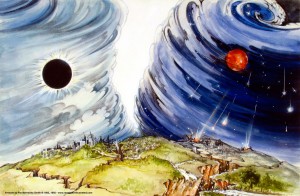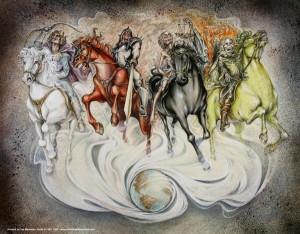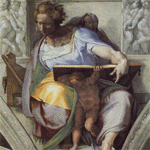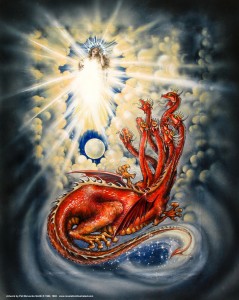![]() his is part three of a three part follow-up series to interpretive articles, “Interpreting the Rules of Revelation” and “The Rapture”. We recommend that you select and read them both if you haven’t already. Then read “Hunting for Key Words the Inductive Way” before continuing with this rapture critique. The hermeneutic principles contained in all three articles will equip you to better understand this and every other study article posted for your interpretive critique.
his is part three of a three part follow-up series to interpretive articles, “Interpreting the Rules of Revelation” and “The Rapture”. We recommend that you select and read them both if you haven’t already. Then read “Hunting for Key Words the Inductive Way” before continuing with this rapture critique. The hermeneutic principles contained in all three articles will equip you to better understand this and every other study article posted for your interpretive critique.
Anyone who dedicates the time to engage a systematic study of the doctrine of the Rapture will come away from the text mentally challenged by the event.
Why?
That God would choose to reconstruct a spirit-based body like Christ’s for the disembodied spirits of His righteous dead and raise them heavenward, while at the same time snatching and changing immortal His embodied church—is mind-boggling.
Hear about it in the congregation or some other teaching venue and we say, “I believe it. Let it come.” But take the time to actually study the prophetic event, and the concept so transcends our mortal understanding that it rattles around the brain pan before sliding down into the spirit where the miraculous makes sense.
Nevertheless, the mind-boggling event will happen. Just as sure as the sun will come up tomorrow, someday the born-again Christian church will be resurrected and raptured when the Father says, “Come.”
But just exactly when and why it will happen has provoked a three-way debate over its timing and theology for years. Will it happen because of the Great Tribulation’s deliverance, or as its reward? Who will be here? And, when, and why, will the Rapture trump blow?
In “Interpreting the Rules of Revelation” we examine the basic principles of hermeneutics. In “Hunting for Key Words the Inductive Way” we took a closer look at key word connection and literal intent. If youve studied both of these articles you should be well equipped to take on this third rapture position through the eyes of God’s observable, literal intent.
Could you be a posttribber? You decide.
Prophecy’s Promise of Deathlessness
RAPTURE: from the Latin word: RAPIO, to “seize or be carried away in one’s spirit.”
New Testament Greek: HARPAZO, to be “caught up.”
Posttribulationalism
From: Answers To 200 Of Life’s Most Probing Questions by Pat Robertson, p.156
I do not find in the Bible the teaching that Christians will be “raptured” prior to the Tribulation.The Bible teaches two comings of Jesus: one, His birth; the second, His coming again in triumph. There is no third coming for a secret rapture. The book of Matthew specifically says, “Immediately after the tribulation of those days…. Then the sign of the Son of Man will appear in heaven…and He will send His angels…and they will gather together His elect from the four winds, from one end of heaven to the other.”
This is just one of many references that indicate we will be going through a time of tribulation until Jesus Christ comes back.
I do believe that Christians will be protected in the midst of tribulation, however. After all, the Israelites were protected when the plagues fell upon Egypt.
Throughout history there have been successive martyrdom’s of Christians, and it is the height of arrogance to assume that only twentieth-century Christians in the United States of America will be spared any kind of persecution. That goes against the flow of history for the last two thousand years. Jesus said, “He who endures to the end shall be saved.” Persecution is simply part of living as a Christian in this world. The saints in China, Russia, and other communist countries have been tortured, have suffered privation, have had their jobs and their families taken away from them. Many of them have already died because of their witness for Jesus. It is hard to contemplate much worse tribulation than these great men and women of faith have already endured.
The posttribulational rapture position teaches that the current church will go through the Great Tribulation, and among other passages, cites the Messianic eschatology of Matthew 24 in support of its view.
Matthew 24:29-31
29 “But immediately after the tribulation of those days the sun will be darkened, and the moon will not give its light, and the stars will fall from the sky, and the powers of the heavens will be shaken,
30 and then the sign of the Son of Man will appear in the sky, and then all the tribes of the earth will mourn, and they will see the Son of Man coming on the clouds of the sky with power and great glory.
31 “And He will send forth His angels with a great trumpet and they will gather together His elect from the four winds, from one end of the sky to the other.”
Okay, so let’s take it apart.
Does the Posttrib Position Have an Eschatological Trumpet?
1 Corinthians 15:51-52
51 Behold, I tell you a mystery; we shall not all sleep, but we shall all be changed,
52 in a moment, in the twinkling of an eye, at the last trumpet; for the trumpet will sound, and the dead will be raised imperishable, and we shall be changed.
Yes. The posttrib trumpet prophesied by Jesus in Matthew 24:30 appears to sound as the last literally recorded trumpet in Scripture’s eschatological texts. Christ prophesied its sounding will signal a gathering together of His elect from the four winds, “after” the Great Tribulation.
The Last Day
Corresponding to this timing hermeneutic, the posttrib position believes Jesus’ eschatology in John 6 reveals a rapture “grand finale.” The Rapture will happen, proponents say, at the last possible moment of premillennial history because of Christ’s literal declarations to “raise His believers” on “the last day.”
John 6:38-40 (also see v. 54)
38 “For I have come down from heaven, not to do My own will, but the will of Him who sent Me.
39 “And this is the will of Him who sent Me, that of all that He has given Me I lose nothing, but raise it up on the last day.
40 “For this is the will of My Father, that everyone who beholds the Son and believes in Him, may have eternal life; and I Myself will raise him up on the last day.”
Synchronizing the simultaneous resurrection/rapture revelation of 1 Thessalonians 4:17 with the “first” resurrection of the tribulation martyrs in Revelation 20, the posttrib position interprets them as one in the same.
Revelation 20:4-5
4 And I saw thrones, and they sat upon them, and judgment was given to them. And I saw the souls of those who had been beheaded because of the testimony of Jesus and because of the word of God, and those who had not worshiped the beast or his image, and had not received the mark upon their forehead and upon their hand; and they came to life and reigned with Christ for a thousand years.
5 The rest of the dead did not come to life until the thousand years were completed. This is the first resurrection.
Posttrib Hermeneutic Critique
That Jesus will raise up His believers on the LAST DAY (John 6:38-40) and gather His elect from the four winds after the Tribulation to be a part of the Eschaton’s “first” resurrection (Matt. 24:29-31; Rev. 20:4,5), is a hermeneutically tenable position. So is the “last trumpet” position blown after the Great Tribulation.
The trumpet prophesied by Jesus in Matthew 24:29 blows after the Great Tribulation, and in a key word search of trumpets throughout Scripture, none appear to blow last after it. So if this trumpet will be a combined Armageddon battle/rapture trump: the “upward” gathering interpretation of this rapture position is true. The present church still living at the time of the Great Tribulation will go through it. And those enduring it to the end will be raptured at its close.
There is also a key word case to be made for the “first” resurrection in this position. If it is the first of those to come for the church, the position has a lock on its timing. But there are some hermeneutic concerns to deal with in the theory.
Where the Word of God Is Bound So Are We
Where It’s Not, We Are Free
First of all, the trumpet prophesied by Jesus in Matthew 24 does appear to sound as the last recorded anywhere in eschatological texts. And Jesus’ prophecy in vvs. 29-31 does specifically acknowledge a coming gathering of His “elect” that will occur “immediately after” the Great Tribulation. But it is only heremeneutically fair to point out that in Jesus’ chapter 5 sermon (the day before he prophesied the last day raising of His faithful), He prophesied a resurrection only, not a rapture.
John 5:25-29
25 “Truly, truly, I say to you, an hour is coming and now is, when the dead shall hear the voice of the Son of God; and those who hear shall live.
26 “For just as the Father has life in Himself, even so He gave to the Son also to have life in Himself;
27 and He gave Him authority to execute judgment, because He is the Son of Man.
28 “Do not marvel at this; for an hour is coming, in which all who are in the tombs shall hear His voice,
29 and shall come forth; those who did the good deeds to a resurrection of life, those who committed the evil deeds to a resurrection of judgment.
Also, when Jesus prophesied the last day raising of His saints in John 6:39,40, He didn’t speak of a harpazo, but used the word, ANISTEMI to “raise,” “erect,” “raise up.”
John 6:39
39 “And this is the will of Him who sent Me, that of all that He has given Me I lose nothing, but raise (anistemi) it up on the last day.
Taking note of these scriptural observations, Jesus could have beat Paul to the punch by introducing a synchronized rapture with the resurrection prophesied in this verse by saying, “I lose nothing, but raise and snatch (anistemi and harpazo) it up on the last day.” But He didn’t. So a rapture inclusion is deductively inferred.
Also, the direction from which His believer’s will be gathered, up, or down is not defined. Jesus’ prophecy in vv. 29-31 simply states this gathering will occur from out of the sky, “from the four winds.” So it is equally possible to interpret this gathering as the downward Armageddon second coming accompaniment of an already raptured church because of a lack of any directional adjective. And many do (Jude 1:14; Rev. 19:11-14).
There is also a chronological question in regard to the first resurrection applied from John’s Revelation 20 text. An inductive search of eternal Bible resurrections shows that the first resurrection listed in Revelation 20 is not technically the first. Christ’s went before it.
1 Corinthians 15:22-23
22 For as in Adam all die, so also in Christ all shall be made alive.
23 But each in his own order: Christ the first fruits, after that those who are Christ’s at His coming,
There is also the very little spoken of resurrection/Jerusalem appearance of “many” of the saints that took place at the point of Jesus’ death (Matt. 27:50-51).
Matthew 27:52-53
52 and the tombs were opened; and many bodies of the saints who had fallen asleep were raised;
53 and coming out of the tombs after His resurrection they entered the holy city and appeared to many.
Who Are These Folks?
There is nothing else said about this startling resurrection. Because it happened in connection with Christ’s resurrection, it is possible that the raised saints in this passage are the “captives led captive” when Jesus “ascended on high,” spoken of in Psalm 68:18 and Ephesians 4:8. And that they now join the company of the two other immortal embodied saints spoken of in Scripture, Enoch and Elijah, who were both taken by God before experiencing death (Heb. 11:5; 2 Kings 2:11). It is all very de-ductive, but possible.
The other possibility is that they were raised and died again. But you would think Luke would have something to say about that in the Book of Acts. Nothing inductive about any of it. It is a great mystery that we are at least given a glimpse of in Matthew’s gospel. If you’ve never thought about it, you’ve probably never engaged a systematic study of Bible resurrections. So think about it now…and welcome to the club!
Other raisings from the dead recorded in Scripture were not eternal, but should be counted when scientifically observing the Bible’s text. The widow of Zarephath’s son (1 Kings 17); the Shunammite widow’s son (2 Kings 4); the dead man raised when thrown in to the ditch touching Elisha’s bones (2 Kings 13); Jesus’ raising of the widow’s son at his own funeral (Luke 7), Jairus’ daughter (Mark 5), Lazarus (John 11); and Tabitha (Acts 9) were all miraculously raised from the dead but would experience death again to await the promised eternal resurrection.
This may seem a little much in weighing the biblical evidence, but it is only good biblical science to take them all into account. First resurrections and last trumpets should provoke the serious student of Scripture to break out Strong’s and Vine’s, and start an intelligent word search. Once you have discovered and considered the nature of every raising, you will find that the “first” resurrection recorded in Revelation 20:5 will take place as number three in a sequence of recorded events.
It is also hermeneutically fair to say the two other eternal resur-rections extraneous to Revelation’s text may have nothing to do with the context of Revelation’s redemptive events. And that the direction of John’s prophecy is set in context of the local truth of earth’s last-days events. If so, the posttribers could be right. The whole idea is to think, and count.
Local Trib-truth
Most important when critiquing the posttrib position is interpreting the local truth that surrounds its “last day raising.” Eschatology’s Great Tribulation will come to pass in a devastating future epoch, and there is a very real problem in determining just exactly who within the timeframe could triumphantly overcome to experience a rapture at its end. Because the position synchronizes with the “first” resurrection in Revelation 20, proponents believe a living church will survive to accompany these martyrs. But it’s hard to find one. Let’s take a look.
Revelation 20:4-6
4 And I saw thrones, and they sat upon them, and judgment was given to them. And I saw the souls of those who had been beheaded because of the testimony of Jesus and because of the word of God, and those who had not worshiped the beast or his image, and had not received the mark upon their forehead and upon their hand; and they came to life and reigned with Christ for a thousand years.
5 The rest of the dead did not come to life until the thousand years were completed. This is the first resurrection.
6 Blessed and holy is the one who has a part in the first resurrection; over these the second death has no power, but they will be priests of God and of Christ and will reign with Him for a thousand years.
A key word search of this key passage reveals two contextual people groups:
1. Those who had not worshiped the beast or his image and had not received his mark upon their forehead and upon their hand, who will also rule with Christ.
2. And resurrected Christ rejecters who according to verses 5 and 6 will be doomed to face a second resurrection at the Great White Throne of Judgment.
The Great Tribulation: the Nature of its End
Because the Word of God is bound in these verses of John’s prophecy, the posttribulation rapture position must believe the raptured church will be the second group (mark rejecters) who will be alive and well when the martyrs are called up. An eschatological study of the era, however, reveals only one symbolic possibility of a surviving Tribulation era church.
Wilderness Hiding?
One of the most powerful demonstrations of prophetic symbolism in Scripture is contained in Revelation 12. In it we are given a parabolic view of Israel and her twelve tribes (woman and twelve crowning stars v. 1); Satan and his followers’ casting out of heaven and Satan’s hatred for Jesus (vv. 3,4); the birth, resurrection, and rapture of Jesus (v. 5); and finally, a predicted escape of the prophetic woman from the eschatological presence of the serpent (vv. 6, 14).
Revelation 12:6, 14, 17
6 And the woman fled into the wilderness where she had a place prepared by God, so that there she might be nourished for one thousand two hundred and sixty days.
14 And the two wings of the great eagle were given to the woman, in order that she might fly into the wilderness to her place, where she was nourished for a time and times and half a time, from the presence of the serpent.
17 And the dragon was enraged with the woman, and went off to make war with the rest of her offspring, who keep the commandments of God and hold to the testimony of Jesus.
If this visual parable alludes to the protection of the church during the exact time period given of three and one half years (2,260 days: 42 months); time (one year); times (two years); half a time (one half year), the church will be kept in hiding during the Great Tribulation. We could then be raptured post-tribulation in synchronization with the “first” resurrection as this position submits.
But if the vision of Revelation 12 speaks of converted natural Israel only (prophetic symbolism will be covered next issue) the testimony of Scripture simply doesn’t bear witness to a surviving Tribulation era church. The political and spiritual climate of the Great Tribulation described in Daniel, Matthew, and Revelation challenge the notion.
Both the teachings of Jesus and John’s Revelation warn of a catastrophic time for all who oppose the Antichrist during this apocalyptic season.
The Abomination of Desolation
After connecting Daniel’s Abomination of Desolation with the Great Tribulation, Jesus prophesied the eschatological period would be an unprecedented era of destruction and death.
Daniel 11:31-36
31 “And forces from him will arise, desecrate the sanctuary fortress, and do away with the regular sacrifice. And they will set up the abomination of desolation.
33 “And those who have insight among the people will give understanding to the many; yet they will fall by sword and by flame, by captivity and by plunder, for many days.
34 “Now when they fall they will be granted a little help, and many will join with them in hypocrisy.
35 “And some of those who have insight will fall, in order to refine, purge, and make them pure, until the end time; because it is still to come at the appointed time.
36 “Then the king will do as he pleases, and he will exalt and magnify himself above every god, and will speak monstrous things against the God of gods; and he will prosper until the indignation is finished, for that which is decreed will be done.
Matthew 24:15-22
15 “Therefore when you see the abomination of desolation which was spoken of through Daniel the prophet, standing in the holy place (let the reader understand)
16 then let those who are in Judea flee to the mountains;
21 for then there will be a great tribulation, such as has not occurred since the beginning of the world until now, nor ever shall.
22 “And unless those days had been cut short, no life would have been saved; but for the sake of the elect those days shall be cut short.
Comparing Daniel’s Abomination of Desolation that will be earmarked by the king’s speaking of monstrous (NAS) things (“Blasphemies,” NKJV), with the Beast’s blasphemous words and actions in Revelation 13, forty-two months (3.5 years) of pure terror will be granted this coming despot over the saints.
Revelation 13:5-10
5 And there was given to him a mouth speaking arrogant words and blasphemies; and authority to act for forty-two months was given to him.
6 And he opened his mouth in blasphemies against God, to blaspheme His name and His tabernacle, that is, those who dwell in heaven.
7 And it was given to him to make war with the saints and to overcome them; and authority over every tribe and people and tongue and nation was given to him.
8 And all who dwell on the earth will worship him, everyone whose name has not been written from the foundation of the world in the book of life of the Lamb who has been slain.
9 If anyone has an ear, let him hear.
10 If anyone is destined for captivity, to captivity he goes; if anyone kills with the sword, with the sword he must be killed. Here is the perseverance and the faith of the saints.
The word overcome in verse 7, (Strong’s 3528, Arnt & Gingrich 539A: nikao) means “to conquer, subdue, overcome, vanquish.”
So if there will be an overcoming living church at the Tribulation’s end, it would have to be hidden away from the Antichrist’s presence. Or it would have to be presumed, because the revelation of the Tribulation era provides no literal evidence of an overcoming, living church.
Jesus’ opening of the fifth seal in Revelation 6 substantiates this truth through its revelation of the tribulation martyrs. (In future issues we will make a case for the seal’s Book of Revelation table of contents purpose.)
Revelation 6:9-10, 14
9 And when He broke the fifth seal, I saw underneath the altar the souls of those who had been slain because of the word of God, and because of the testimony which they had maintained;
10 and they cried out with a loud voice, saying, “How long, O Lord, holy and true, wilt Thou refrain from judging and avenging our blood on those who dwell on the earth?”
14 “These are the ones who come out of the great tribulation, and they have washed their robes and made them white in the blood of the Lamb.”
“Mark-rejecters” who can be found during this horrible period will die by “the sword; famine (forced); pestilence, death (Strong’s 2288, Arnt and Gingrich 350D thanatos: “death and the fear of it”). And by the wild beasts of the field (possibly wild animals crazed by demonic possession, or even a re-opened Roman coliseum) as revealed by the sickly green horseman in Revelation 6:8:
8 And I looked, and behold, an ashen horse; and he who sat on it had the name Death; and Hades was following with him. And authority was given to them over a fourth of the earth, to kill with sword and with famine and with pestilence and by the wild beasts of the earth.
Apocalypse (and other stuff) Now! Conclusions
The posttribulational rapture positions applies a mix of literal and free interpretations in developing its conclusions.
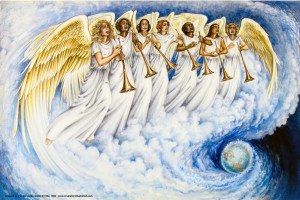
The Last Trumpet
Matthew 24:31
31 “And He will send forth His angels with a great trumpet and they will gather together His elect from the four winds, from one end of the sky to the other.
The last trumpet prophesied by Jesus in Matthew gathers His elect from the four winds after the tribulation. So this position definitely has a lock on the chronology of a last sounding trumpet.
But the direction from which we will be gathered, “up,” or “down,” isn’t distinguished. So a downward gathering to accompany Christ to the Battle of Armageddon can just as easily be inferred.
The Last Day
John 6:39
39 “And this is the will of Him who sent Me, that of all that He has given Me I lose nothing, but raise it up on the last day.”
The last day prophesied by Jesus on which He will raise His be-lievers in John 6:39,40 speaks of a resurrection only anistemi: to “raise,” “erect,” “raise up”; not a rapture, though a rapture can be deduced.
The First Resurrection
Revelation 20:4-5
4 And I saw thrones, and they sat upon them, and judgment was given to them. And I saw the souls of those who had been beheaded because of the testimony of Jesus and because of the word of God, and those who had not worshiped the beast or his image, and had not received the mark upon their forehead and upon their hand; and they came to life and reigned with Christ for a thousand years.
5 The rest of the dead did not come to life until the thousand years were completed. This is the first resurrection.
Bearing in mind the deadly nature of the Great Tribulation, it is probable that the first resurrection revealed in Revelation 20:4 refers to the first of two eschatological resurrections prophesied within the context of chapter 20 text. The first at the end of the Tribulation involving those who are saved during the epoch and lose their lives for it. The second at the end of the Millennium consisting of the resurrection of Christ’s rejecters throughout the ages who will face the second death.
Revelation 20:6
6 Blessed and holy is the one who has a part in the first resurrection; over these the second death has no power, but they will be priests of God and of Christ and will reign with Him for a thousand years.
If the rapture of an overcoming, living church will take place in sync with the first resurrection, it would have to be kept protected, as possibly described in the prophetic symbolism of Revelation 12: 6,14.
Revelation 12:14
14 And the two wings of the great eagle were given to the woman, in order that she might fly into the wilderness to her place, where she was nourished for a time and times and half a time, from the presence of the serpent.
Or it would have to be freely inferred, because the nature of the Great Tribulation leaves little room for interpreting an overcoming, surviving church.
Revelation 13:7, 10
7 And it was given to him to make war with the saints and to overcome them; and authority over every tribe and people and tongue and nation was given to him.
10 If anyone is destined for captivity, to captivity he goes; if anyone kills with the sword, with the sword he must be killed. Here is the perseverance and the faith of the saints.
Amillennialism and Preterism: FYI
Two final rapture, or rather, anti-rapture views that deserve at least mentioning in this critique are the Amillennial, and Preterist views. Amillennialism (“no”-millennium) believes the post-rapture thousand year reign of Christ to be a spiritual analogy of the church and interprets Revelation 20 as a recapitulation of the church age. Preterism believes the plagues, politics, and a “spiritual” Second Coming of Christ were fulfilled during the 70 A.D. sack of Jerusalem.
Neither of these positions give literal credence to the resurrection/ rapture eschatology of Paul. So an overall hermeneutic of Scripture rejects both. But we have included them to give you at least a working understanding of the positions if the subject is ever brought up.
Where the Word of God Is Bound, So Are We
Where It’s Not, We Are Free
Study, Pray, and Think!
So, there you have it. The Rapture, all three views. When and why will the Rapture trump blow? Will it happen because of the Great Tribulation’s deliverance? Or as its reward?
You decide!
If you’ve read all six of our offered articles, take some time to study and restudy the concerned texts. If you haven’t read “Interpreting the Rules of Revelation” and “Hunting for Key Words the Inductive Way,” you’ve put the cart before the horse as so many who glibly believe their favorite “prophecy expert” and parrot their views.
Become Your Own Eschatologian!
It’s Up to You!
Apocalypse (and other stuff) Now! is the thinking Christian’s eschatology journal. That you have taken the time to read and consider our content shows you are a thinker. So please continue to study, pray, and think! Too many of us within the church today (both readers and writers) approach the study of God’s Word through the eyes of a favorite expert or commentary rather than through an honest observation of what has actually been said. Especially our views of the Rapture. Because this is true, many passages when “studied” go completely “unstudied” as words are sloppily overlooked and even unconsciously inserted to substantiate previously formulated doctrines or beliefs.
Eschatology is very evangelistic when you know what you’re talking about.
So come out from among those huddled in the prophecy parrot cage who simply repeat what their favorite expert teaches, regardless of studying the Bible’s texts. “Polly want a rapture! Squawk!!!”
Start a Rapture Sunday school class at your church that studies all three views.
We have given you the tools.
The rest is up to you.
Pretrib, midtrib, or posttrib…which are you?
Eschatology Today Publisher, Mark Norris MA

